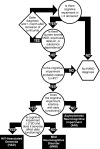Cognitive neuropsychology of HIV-associated neurocognitive disorders
- PMID: 19462243
- PMCID: PMC2690857
- DOI: 10.1007/s11065-009-9102-5
Cognitive neuropsychology of HIV-associated neurocognitive disorders
Abstract
Advances in the treatment of the human immunodeficiency virus (HIV) have dramatically improved survival rates over the past 10 years, but HIV-associated neurocognitive disorders (HAND) remain highly prevalent and continue to represent a significant public health problem. This review provides an update on the nature, extent, and diagnosis of HAND. Particular emphasis is placed on critically evaluating research within the realm of cognitive neuropsychology that aims to elucidate the component processes of HAND across the domains of executive functions, motor skills, speeded information processing, episodic memory, attention/working memory, language, and visuoperception. In addition to clarifying the cognitive mechanisms of HAND (e.g., impaired cognitive control), the cognitive neuropsychology approach may enhance the ecological validity of neuroAIDS research and inform the development of much needed novel, targeted cognitive and behavioral therapies.
Figures
References
-
- American Academy of Neurology AIDS Task Force Nomenclature and research case definitions for neurologic manifestations of human immunodeficiency virus-type 1 (HIV-1) infection. Neurology. 1991;41:778–785. - PubMed
-
- Archibald SL, Masliah E, Fennema-Notestine C, Marcotte TD, Ellis RJ, McCutchan JA, et al. Correlation of in vivo neuroimaging abnormalities with postmortem human immunodeficiency virus encephalitis and dendritic loss. Archives of Neurology. 2004;61:369–376. - PubMed
-
- Arendt G, Hefter H, Elsing C, Strohmeyer G, Freund HJ. Motor dysfunction in HIV-infected patients without clinically detectable central-nervous deficit. Journal of Neurology. 1990;237(6):362–368. - PubMed
-
- Aylward EH, Henderer JD, McArthur JC, Brettschneider PD, Harris GJ, Barta PE, et al. Reduced basal ganglia volume in HIV-1-associated dementia: results from quantitative neuroimaging. Neurology. 1993;43:2099–2104. - PubMed


